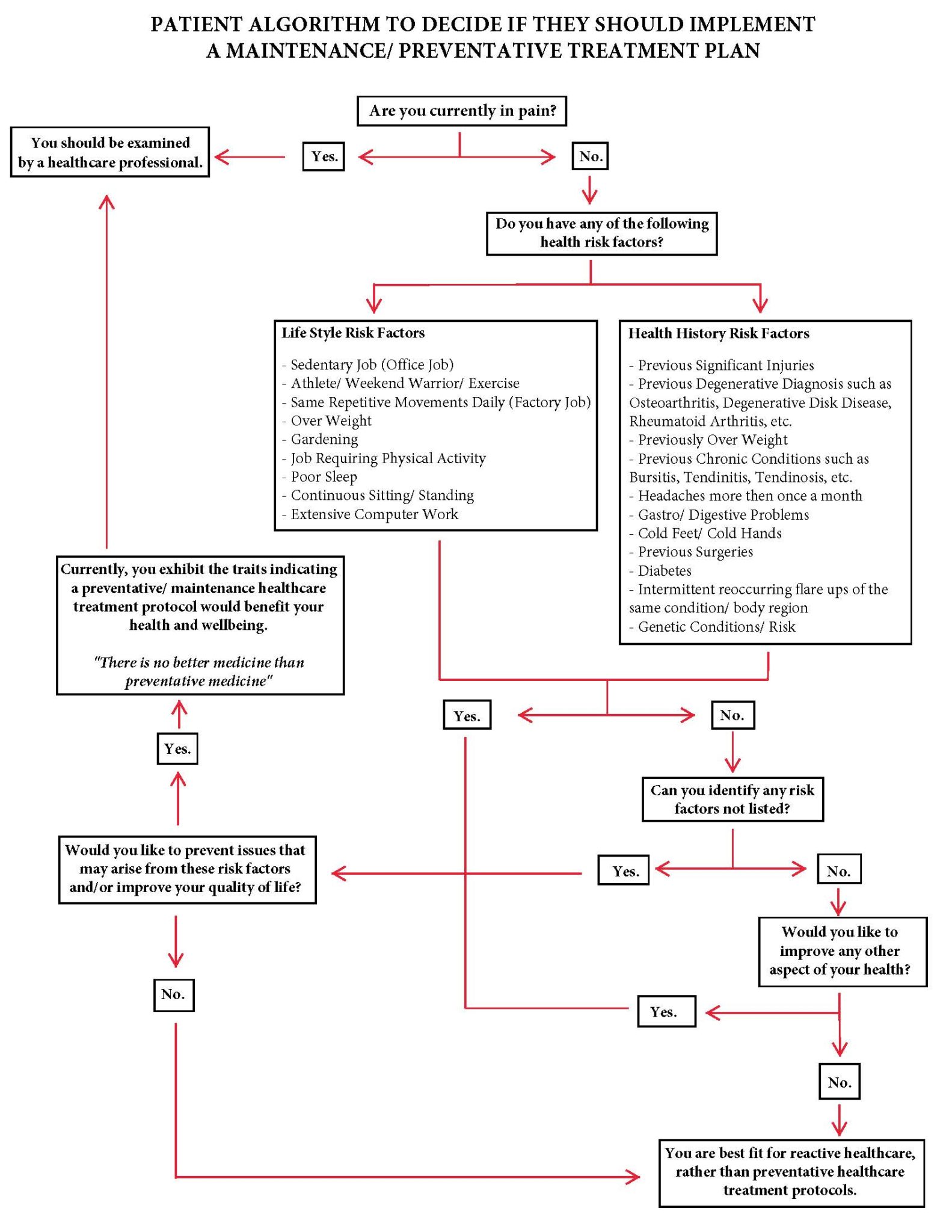Should you implement Maintenance or Preventative Treatment?
Why Maintenance Care?
Typically, most patients come to see me when they are in pain or discomfort and our team helps them get back to their current health status prior to the acute issue.
But what happens after that?
Once a patient’s acute pain, discomfort or condition has resolved, they’re often left wondering if they should get maintenance or preventative treatments. Well the answer is a little more complex then a simple yes or no answer.
In this article, I will discuss the route for you to take to make that informed health decision and give you a very basic algorithm to follow to help you decide.
But first, lets discuss what exactly maintenance or preventative treatment/care entails…
What is Maintenance or Preventative Care/ Treatment?
Preventative or Maintenance Care/ Treatment is a whole body treatment which addresses any developed imbalances, impedances, functions, etc. in which are risk factors for disease and dysfunction. These risk factors can be triggered by several variables like work, stressors, physical activity, environmental, postural, congenital, etc. Our body makes adaptations and self regulates to these variables which often leads to chronic conditions down the road. Preventative treatment addresses these adaptations our body is trying to self regulate and steers it down the right path so we avoid long term implications.
A simplistic example of this is how sitting at a desk all day can effect our body’s anatomy. This can lead to tension, headaches, muscle imbalances, rounding of the shoulders, straightening of the normal curvature in your spine, inflammation, etc. – All of which would be addressed in our preventative/ maintenance care and treatment protocol in order to come up with a treatment plan to mitigate the risk of developing chronic pain, restricted movement, etc.
What does a preventative or maintenance appointment entail?
SUBJECTIVE:
-
- We would be reviewing your personal health history to find potential risk factors from previous injuries, occupation, symptomology (past/ present), surgical history, past/present conditions, family history, current health status, etc.
- Review any previous diagnostic imaging and/or order new imaging if necessary.
- Review of your personal goals for treatment.
Of course if you are already a patient of mine, I will have already reviewed the above; however, we as we are transitioning from acute pain to preventative treatment, we will be reviewing this information again but looking at it with a different perspective.
PHYSICAL EXAMINATION/ OBJECTIVE:
-
- Perform a whole body physical examination based around on your risk factors identified in our assessment.
Breakdown of this physical examination:
-
-
-
- General Appearance, Cardiovascular, Lymphatic, Neurological
- Pain Scale
- Gait and Station Assessment
- Spinal Curves
- Craniosacral Mechanism
- Reflex and Motor Nerve Testing
- Special Tests (Orthopedic Testing)
- TART Somatic Dysfunction Examination (Tissue Texture Changes, Asymmetry of Anatomic Landmarks, Range of Motion Abnormalities, and Tenderness
-
-
ASSESSMENT:
-
- Review of our findings. This is where we explain to the patient exactly what we have determined based on our reviewal of the health history and assessments. We will explain everything in great detail so the patient is well educated on their current health status.
- We find that when patients are knowledgable on their condition(s) the better they are able to manage, understand, and prevent future issues. Ultimately leading to a better prognosis!
PLAN:
-
- This is where we discuss the treatment plans available for your current health status. We always offer the best available treatment option based on the most current scientific evidence that proves the best prognosis for the patient’s current health status.
- However, we will take into account the variables which are relevant to the individual patient to come up with the best treatment plan for each individual. Variables that may be important to the patient may include: financials, time, goals, etc.
We will do our very best to accommodate the patient’s variables into their treatment plan; however, it is important to note that all expectations may not be met as more variables interfere with the original prescribed treatment plan. This will all be discussed with the patient at this time of the appointment.
-
- The patient’s treatment plan may include, but not limited to, the following: Osteopathic Manipulative Therapy, Physiotherapy Modalities, Nutritional Advise, Prescription of Orthopedic Support Products, Home Therapeutic Exercise Programs, Lifestyle Advise, and Referrals to Specialists/ additional Allied Healthcare Providers.
So how do you decide if you need maintenance/ preventative care?
Now that you know what Preventative/ Maintenance Treatment and Assessment actually does, how do you decide that you need it?
Below is an algorithm I’ve developed to help patient’s decide if they should explore this health opportunity.

In Conclusion…
Now that you have all the information about preventative or maintenance treatment, you are able to make the informed decision if it is right for you and your health.
In my professional opinion, there are not too many people (if any) whom shouldn’t implement some sort of preventative healthcare into their life due to the ongoing stressors and risk factors throughout our daily lives.
Correcting issues and addressing risk factors before pain or dysfunction can prevent big issues from arising and can significantly improve your quality of life.
“You don’t have to cure a disease, which you never had”
If you believe you should be implementing a maintenance or preventative treatment program into your life, I would be glad to help you along that process. Please give our office a call to schedule your assessment or reassessment if you have been my patient in the past.
Questions or Concerns? Please reach out, we would be glad to assist you in anyway we are able to do so.


